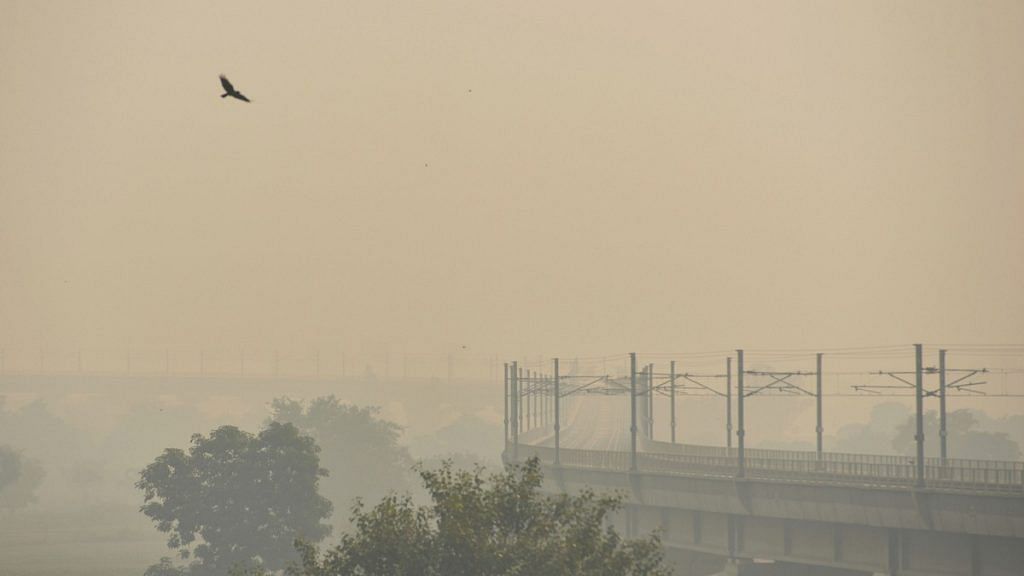New Delhi: Diwali is long gone and the peak crop burning season is over. But severe pollution is back in Delhi.
With the national capital recording ‘severe’ category pollution again this week, experts have suggested that Delhi needs a less reactionary and more consistent and dynamic response system to battle the toxic winter smog.
On Thursday morning, the AQI was recorded at 410 in Delhi. According to SAFAR, the pollution monitoring body of the Ministry of Earth Sciences, the dominating factor that caused the air quality to deteriorate was a parameter called the “mixing height”.
Mixing height describes the vertical height at which pollutants are able to disperse. A higher mixing height would allow suspended particles to rise with warm air and dissipate.
The agency also noted that the fire counts — indicating instances of crop burning in the states of Punjab and Haryana — are too low to significantly cause pollution in Delhi.
Also read: Air pollution is actually making our children dumber
Call for ‘airshed’ approach
While the prevalent factors indicate the current predicament may be of Delhi’s own making, researchers from IIT Delhi suggest that the city needs to start looking at pollution with an “airshed” approach. An airshed is a part of the atmosphere that behaves in a coherent way with respect to the dispersion of emissions.
According to Sagnik Dey, a researcher at IIT Delhi, various areas of the Indo-Gangetic plain can be divided into ‘airsheds’ — each of which needs a customised pollution response plan. He said looking at pollution from the lens of states leads to very short-term solutions.
For instance, the Supreme Court, in an order in 1996, had directed all kilns operating in Delhi to be shut down. As a result, the brick kilns moved to areas bordering the capital — Ghaziabad, Noida, Bhagpat and Meerut for example.
However, since these cities fall in the same airshed as New Delhi, the move did very little to help the capital’s pollution problem, Dey told ThePrint.
Why a dynamic response system is needed
Apart from long-term pollution management, Delhi and North India on the whole needs a more dynamic response plan, feel the experts.
The Graded Response Action Plan (GRAP), which was prepared by the Central Pollution Control Board and first implemented in Delhi-NCR in 2017, lists measures to curb air pollution according to the severity of the situation.
When air quality turns “severe”, GRAP recommends closure of brick kilns, stone crushers and hot mix plants, sprinkling of water, frequent mechanised cleaning of roads and maximising power generation from natural gas.
However, this action plan kicks in as a reactionary measure only when the air is already unbreathable, said a CPCB official, who did not wish to be named.
For example, the Odd-Even scheme was started on 4 November this year, on the week that SAFAR had already predicted good air quality. The scheme was lifted on 15 November, while Delhi was still choking from severe air quality.
“SAFAR has already demonstrated that its weather-based prediction model is reasonably robust, so we should now design an action plan that responds to predictions,” the CPCB official said.
Ronak Sutaria, a PhD student at IIT Bombay and founder of UrbanSciences, which sells affordable air monitors, said air quality monitoring is limited in areas outside major cities.
This hampers air pollution management policies, a lot of which is city-centric and leaves out rural areas that have no monitors.
SAFAR predicts that an increase in surface winds and scattered rainfall by Thursday evening will improve the AQI. By 14 December, the air quality is forecast to improve towards the lower end of ‘poor’ to the ‘moderate’ category.
Also read: To fight India’s airpocalypse, Modi govt must first centralise air pollution policy
